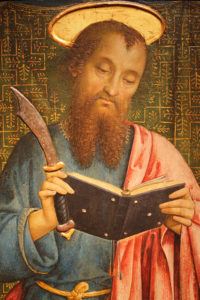

Very little is know about Bartholomew. We do know he was one of the 12 apostles and traveled around with Jesus during his ministry. He is not mentioned by name often in the bible but he is included in the listing of the apostels (Mark 3:18, Matt. 10:3, Luke 6:14, and Acts 1:13)
He is also referred to as Nathanial. Bartholomew is the family name, meanin "son of (Hebrew: bar) Tolmai (or Talmai). We also see him closely associated with St. Philip.
We do have the opportunity to learn about Bartholomew being called to be a disciple in John 1:43-51. "The next day Jesus decided to go to Galilee. He found Philip and said to him, “Follow me.” Now Philip was from Bethsaida, the city of Andrew and Peter. Philip found Nathanael and said to him, “We have found him of whom Moses in the Law and also the prophets wrote, Jesus of Nazareth, the son of Joseph.” Nathanael said to him, “Can anything good come out of Nazareth?” Philip said to him, “Come and see.” Jesus saw Nathanael coming toward him and said of him, “Behold, an Israelite indeed, in whom there is no deceit!” Nathanael said to him, “How do you know me?” Jesus answered him, “Before Philip called you, when you were under the fig tree, I saw you.” Nathanael answered him, “Rabbi, you are the Son of God! You are the King of Israel!” Jesus answered him, “Because I said to you, ‘I saw you under the fig tree,’ do you believe? You will see greater things than these.” And he said to him, “Truly, truly, I say to you, you will see heaven opened, and the angels of God ascending and descending on the Son of Man.”" (ESV)
Even though we have no other Biblical writing about Bartholomew we do know that he did see "greater things than these". He saw Christ's miricles, heard his teachings, saw our Lord crucified on a cross, and was there in the locked room when Jesus showed his risen self to his disciples. The things he saw were what he then took with him on his missionary journies. Church history holds that he traveled to Ethiopia, Mesopotamia, Parthia (in modern Iran), Lycaonia (in modern Turkey), and Armenia. It was there in Armenia that his martyrdom occured, the Armenian king, Astyages, had him flayed alive and then beheaded.
August 24, is oftened set aside as his feast day in the church and because of how he died, he is often protrayed in artwork holding his own flayed skin.

Visit Concordia Publishing House to read more about St. Bartholomew, including a devotion and prayer.